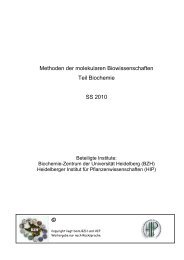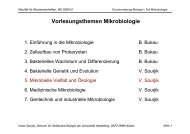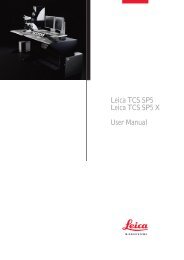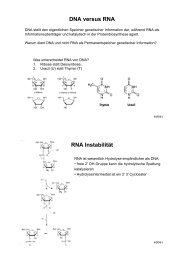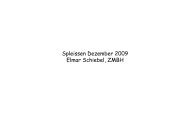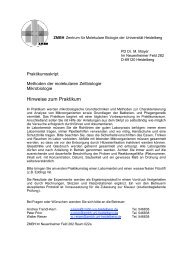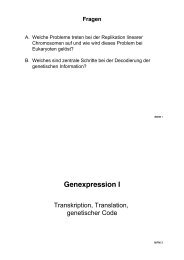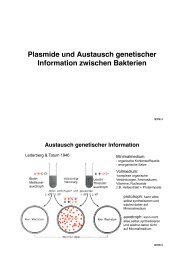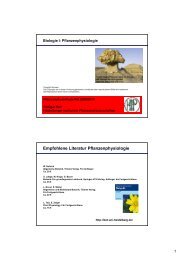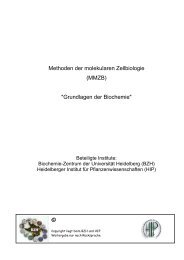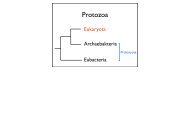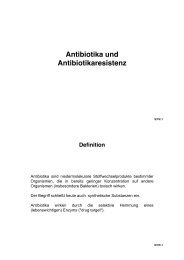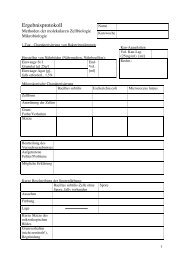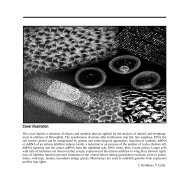ZMBH J.Bericht 2000 - Zentrum für Molekulare Biologie der ...
ZMBH J.Bericht 2000 - Zentrum für Molekulare Biologie der ...
ZMBH J.Bericht 2000 - Zentrum für Molekulare Biologie der ...
Create successful ePaper yourself
Turn your PDF publications into a flip-book with our unique Google optimized e-Paper software.
switches between a GDP- and a GTP-bound form. Its<br />
nucleotide-bound state is controlled by a number of<br />
activities whose asymmetric nucleocytoplasmic distribution<br />
is thought to result in a high nuclear RanGTP<br />
concentration and very low RanGTP levels in the cytoplasm.<br />
Importin-β like transport receptors are RanGTP<br />
binding proteins that respond to this gradient by<br />
loading and unloading their cargo in the appropriate<br />
compartment. Importins bind their substrates in the<br />
absence of RanGTP, i.e. in the cytoplasm and release<br />
them upon encountering RanGTP in the nucleus. The<br />
importins then return to the cytoplasm where RanGTP<br />
is released (involving GTP hydrolysis), thereby allowing<br />
the importin to bind and import the next cargo molecule.<br />
Exportins respond to the RanGTP gradient in<br />
exactly the opposite way; they bind their cargo preferentially<br />
in the presence of RanGTP in the nucleus,<br />
where they form a trimeric substrate-exportin-RanGTP<br />
complex. The trimeric export complex is disassembled<br />
after export to the cytoplasm and the „empty“ exportin<br />
can re-enter the nucleus to participate in another round<br />
of export.<br />
Transport receptors bind their transport substrates in<br />
many cases directly, an example being nuclear export<br />
of tRNA by exportin-t (see below). In other cases, substrate<br />
recognition is more complicated and involves an<br />
adapter molecule. The best studied example for that is<br />
the classical NLS import pathway, where the NLS is<br />
recognised by the adapter importin α, which in turn<br />
binds the actual transport receptor importin beta. This<br />
complicates the corresponding transport cycle consi<strong>der</strong>ably<br />
in that not only importin β, but also importin<br />
α needs to be return to the cytoplasm. Interestingly,<br />
importin α employs a specialised exportin, namely<br />
CAS, for this purpose.<br />
68<br />
Figure 1: Transport cycles of Importins (Imp) and exportins<br />
(Exp). For details, please see main text.<br />
Recycling of snurportin 1 back to the cytoplasm<br />
F. Paraskeva, U. Kutay, in collaboration with R. Lührmann<br />
(Univ. Marburg), F.R. Bischoff (DKFZ, Heidelberg),<br />
E. Izaurralde (EMBL, Heidelberg)<br />
Snurportin 1 functions as an import adapter for U<br />
snRNPs. It recognises the m 3 G-cap import signal of<br />
U snRNPs and also binds Importin β which in turn<br />
is the actual mediator of import. Just as importin α,<br />
also snurportin 1 needs to be returned to the cytoplasm<br />
after each round of import in or<strong>der</strong> to accomplish further<br />
import cycles. We found that this recycling is<br />
mediated by CRM1. CRM1 was originally identified<br />
as the exportin specific for leucine-rich nuclear export<br />
signals (NESs). However, the CRM1/ snurportin 1<br />
interaction differs significantly from that with other<br />
export substrates: Firstly, snurportin 1 binds CRM1<br />
not through a short, leucine-rich signal, but instead<br />
through a large domain that comprises more than 200<br />
residues. Secondly, snurportin 1 binds CRM1 100<br />
times more tightly than an NES from the HIV Rev<br />
protein. In addition, snurportin 1 can bind either the<br />
m 3 G-cap import signal or CRM1, but not both at the<br />
same time. This property ensures that CRM1 exports<br />
only those snurportin 1 molecules which have already<br />
released their cargo and thereby allows snurportin 1 to<br />
mediate productive import cycles.<br />
tRNA export<br />
U. Kutay, G. Liposwsky, P. Schwarzmaier, in collaboration<br />
with E. Izaurralde (EMBL, Heidelberg) and<br />
F.R. Bischoff (DKFZ, Heidelberg)<br />
tRNAs are synthesised as precursor molecules (pretRNAs),<br />
mature to functional tRNA and finally get<br />
exported to the cytoplasm. There, they participate in<br />
cycles of aminoacylation, binding to the elongation<br />
factor eE1A and function in translation. We have identified<br />
exportin-t as the tRNA-specific exportin and<br />
showed that it functions according to the exportinparadigm<br />
described above. The maturation of pretRNAs<br />
to functional tRNAs involves trimming of the<br />
3´and 5´ends, post-transcriptional addition of the 3´<br />
CCA end to which the amino acid is later attached,<br />
and the modification of a number of nucleosides. It<br />
is quite remarkable that exportin-t preferentially binds<br />
and exports mature tRNA which contain correctly processed<br />
3´and 5´ends and the appropriate nucleoside<br />
modifications. Exportin-t mediated export thus constitutes<br />
a proof-reading or quality-control mechanism<br />
that co-ordinates RNA processing with export and<br />
thereby helps to ensure that only functional tRNA<br />
arrives in the cytoplasm.<br />
Nuclear import of ribosomal proteins and<br />
histone H1<br />
S. Jäckel<br />
The biogenesis of ribosomes is a very complex process<br />
that also involves nuclear import and export events:<br />
Ribosomal proteins are first imported from the cytoplasm,<br />
assemble with rRNA in the nucleolus to form<br />
ribosomal subunits which are then finally re-exported<br />
to the cytoplasm.<br />
We have studied nuclear import of ribosomal proteins<br />
in higher eukaryotes, focusing on rpL23a. We found<br />
that at least 4 distinct transport receptors, namely<br />
importin β, transportin, importin 5 and importin 7<br />
can directly bind and import rpL23a. This not only<br />
assigned the first functions to importin 5 and 7,<br />
but showed an apparently quite common principle<br />
in nuclear import, namely that some substrates can<br />
„choose“ between several carriers. L23a binds through<br />
the same domain or „import signal“ to each of the 4<br />
transport receptors.<br />
69



